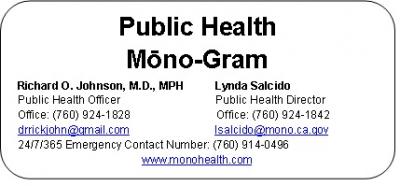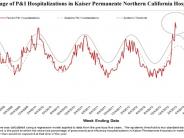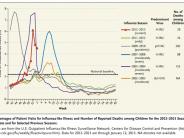Mono-Gram - Flu and Norovirus 2/14/13
February 14, 2013
Double Trouble – First Flu, now Flu AND Norovirus
We continue to see widespread influenza activity in California, with levels above epidemic thresholds for the 7th straight week. During an average influenza season, there are 12 weeks during which the rates of influenza-like illness exceed the level that the CDC considers the national baseline. Last year, there was only one week, and only 4 states reported high levels of activity. This year, 48 states have already reported widespread activity, with the earliest onset since 2003-2004.
The timing and severity of flu viruses and seasons is highly variable and difficult to predict. Therefore, we still do not know for how long and how serious this season will turn out to be. Although evidence shows decreased activity on the East Coast and southeast where it all started this year, the West Coast, including the Eastern Sierra, is still showing high levels of activity, which are hopefully peaking. Locally we have seen influenza-associated hospitalizations, but fortunately no deaths, which are increasing rapidly across the state, especially among persons 65 years of age or older.
Although getting late, you can still get your flu shot at your provider, pharmacy, or health department. Wash your hands frequently. If you get sick, stay home! Cover your cough, drink plenty of fluids, and call your healthcare provider if you are concerned, especially if you are pregnant or have any chronic medical condition. The vaccine is a good match, and the antiviral drug Tamiflu may prevent complications if you are at high risk.
You have heard about norovirus, famous as the bug that causes such misery on cruise ships. Although not related to influenza, norovirus illness is commonly called “stomach flu”. You have probably had it more than once in your lifetime, with sudden onset of stomach cramping, vomiting, and diarrhea. There is no vaccine to prevent it, and no drug to treat it. Most people get better in 1-2 days; however, the very young, the elderly, or people with other health conditions can become dehydrated, resulting in hospitalization and even death. Each year in the US, there are about 20 million cases, with over 70,000 hospitalizations, and 800 deaths.
A new strain from Australia is causing a higher number of cases this year. Over 60% of the 137 laboratory confirmed outbreaks so far this winter in California have been caused by this new strain, most in long-term care facilities. We are investigating the report of a possible outbreak in Mono County this past week.
Although thought of as a cause of “food poisoning”, it is not so much the food as it is really the food handler that brings it to the table! Norovirus spreads quickly in places like long-term care facilities, day care centers, schools, hotels, restaurants, potlucks, and catered-meal settings. Prevention? You have heard it before – wash your hands – frequently - especially after using the toilet and changing diapers and always before preparing or eating food. People are contagious from the moment they feel sick until at least 3 days after they recover, and perhaps even longer. DO NOT PREPARE FOOD FOR OTHERS WHILE INFECTED OR RECENTLY SICK.




